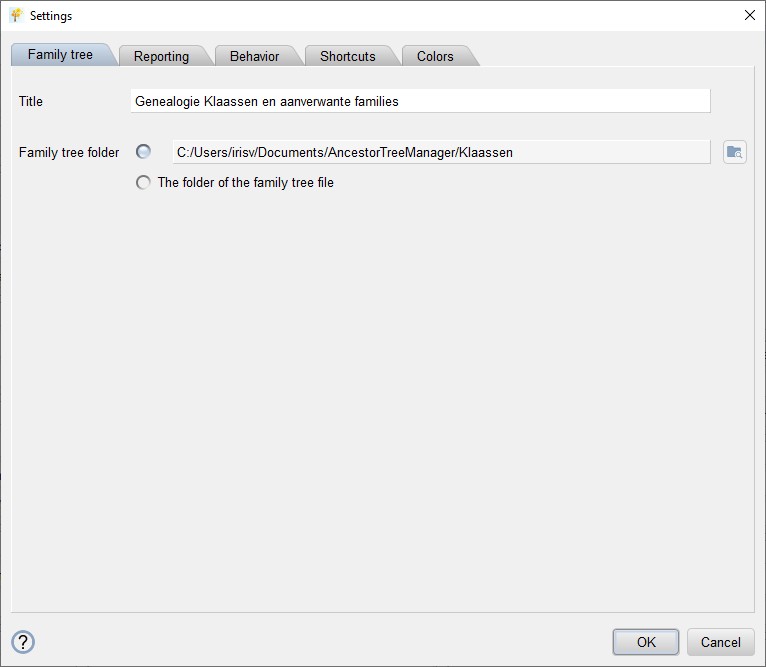| Ancestor Tree Manager |
Report settings
The settings related to the reporting can be found under .
- The Family tree tab shows the settings that differ per family tree and are stored with the data of the family tree.
- The Reporting tab shows the general settings that are stored per user (like all other settings).
Family tree

| Title | The text that is displayed at the top of every HTML page of the reporting (optional) |
| Family tree folder | The folder for all files concerning a specific family tree, for an extensive explanation see page Folders and files |
Reporting

General
This section applies to all report pages.
| Show private persons | Whether or not people must be included in the reporting who are not marked as 'deceased' or who can be assumed dead based on their date of birth, date of marriage, etc. |
| Language | The language for the reports can be chosen independently of the language of ATM |
| Date format | This is the format used in the reporting, with the exception of the index pages, where only a numerical notation is applied to allow sorting of the column |
| Data order | Date followed by place name or vice versa |
| Text balloon position | The position of the text balloon that appears when clicking the Source button |
Currently the following languages are supported for the reports:
- English
- Dutch
- German
- French
- Norwegian
Index pages
| Style |
Simple: for each letter of the alphabet an index page with a table of all people whose last name starts with that letter Two-stage: for each letter of the alphabet an index page with a table of all surnames that start with that letter plus in addition for each surname its own index page with a table of all persons with that surname |
| Date of last modification | The column 'Last modification' is optional |
Reports
These settings relate to the various reports:
- Ancestor tree
- Descendant tree
- Genealogy
The Google Maps button behind a placename does a search with the full place name.
Settings for the descendant tree also apply to the genealogy.
Style:
- Per branch
- Per generation
Numbering:
- Arabic nested
- Roman number + letter
Person page
The list on the left speaks for itself.
The list on the right contains all the facts.
If requested, an Ancestors button can be displayed on the person page, with which a graphical overview of several generations of ancestors can be viewed. When a person does not have grandparents, the button is irrelevant and will therefore not be displayed.
The Google Maps button behind a placename does a search with the full place name.
The Google Maps button behind an address does a search with the placename plus the name of the country (if specified). The street name is not included in the search because this often leads to unwanted results.
 Settings
Settings